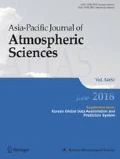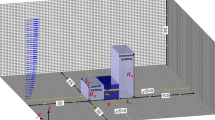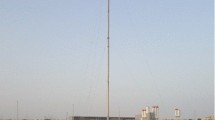Abstract
The effects of building-roof cooling on flow and air temperature in 3D urban street canyons are numerically investigated using a computational fluid dynamics (CFD) model. The aspect ratios of the building and street canyon considered are unity. For investigating the building-roof cooling effects, the building-roof temperatures are systematically changed. The traditional flow pattern including a portal vortex appears in the spanwise canyon. Compared with the case of the control run, there are minimal differences in flow pattern in the cases in which maximum building-roof cooling is considered. However, as the building roof becomes cooler, the mean kinetic energy increases and the air temperature decreases in the spanwise canyon. Building-roof cooling suppresses the upward and inward motions above the building roof, resultantly increasing the horizontal velocity near the roof level. The increase in wind velocity above the roof level intensifies the secondarily driven vortex circulation as well as the inward (outward) motion into (out of) the spanwise canyon. Finally, building-roof cooling reduces the air temperature in the spanwise canyon, supplying much relatively cool air from the streamwise canyon into the spanwise canyon.
Similar content being viewed by others
References
Akbari, H., H. D. Matthews, and D. Seto, 2012: The long-term effect of increasing the albedo of urban areas. Environ. Res. Lett., 71, 1–10.
Baik, J.-J., and J.-J. Kim, 1998: A numerical study of flow and pollutant dispersion characteristics in urban street canyons. J. Appl. Meteorol., 38, 1576–1589.
Kim, J.-J., and J.-J. Baik, 1999: A numerical study of thermal effects on flow and pollutant dispersion in urban street canyons. J. Appl. Meteorol., 38, 1249–1261.
____, and _____, 2001: Urban street-canyon flows with bottom heating. Atmos. Environ., 35, 3395–3404.
____, and_____, 2005: Physical experiments to investigate the effects of street bottom heating and inflow turbulence on urban street-canyon flow. Adv. Atmos. Sci., 22, 230–237.
____, and _____, 2010: Effects of street-bottom and building-roof heating on flow in three-dimensional street canyons. Adv. Atmos. Sci., 27, 513–527.
Kim, M., R. Park, and J.-J. Kim, 2012: Urban air quality modeling with full O3-NOx-VOC chemistry: Implications for O3 and PM air quality in a street canyon. Atmos. Environ., 47, 330–340.
Kovar-Panskus, A., L. Moulinneuf, E. Savory, A. Abdelqari, J.-F. Sini, J.-M. Rosant, A. Robins, and N. Toy, 2002: A wind tunnel investigation of the influence of solar-induced wall-heating on the flow regime within a simulated urban street canyon. Water Air Soil Pollut. Focus, 2, 555–571.
Niachou, A., K. Papakonstantinou, M. Santamouris, A. Tsangrassoulis, and G. Mihalakakou, 2001: Analysis of the green roof thermal properties and investigation of its energy performance. Energ. Buildings, 33, 719–729.
Niachou, K., I. Livada, and M. Santamouris, 2005: A study of temperature and wind distribution inside two urban street canyons in Athens. International Conference on Passive and Low Energy Cooling for the Built Environment, Santorini, Greece, 125–131.
Richards, K., M. Schatzmann, and B. Leitl, 2006: Wind tunnel experiments modelling the thermal effects within the vicinity of a single block building with leeward wall heating. J. Wind Eng. Ind. Aerod., 94, 621–636.
Sini, J.-F., S. Anquetin, and P. G. Mestayer, 1996: Pollutant dispersion and thermal effects in urban street canyons. Atmos. Environ., 30, 2659–2677.
Uehara, K., S. Murakami, S. Oikawa, and S. Wakamatsu, 2000: Wind tunnel experiments on how thermal stratification affects flow in and above urban street canyons. Atmos. Environ., 34, 1553–1562.
Xie, X., C.-H. Liu, and D. Y. C. Leung, 2007: Impact of building facades and ground heating on wind flow and pollutant transport in street canyons. Atmos. Environ., 41, 9030–9049.
____, _____, _____, and M. K. H. Leung, 2006: Characteristics of air exchange in a street canyon with ground heating. Atmos. Environ., 40, 6396–6409.
Yoon, Y.-H., B.-J. Park, and W.-T. Kim, 2006: Current states of rooftop greening in Japan. J. Korean Soc. People Plants Environ., 9, 27–32. (in Korean with English abstract)
Author information
Authors and Affiliations
Corresponding author
Rights and permissions
About this article
Cite this article
Kim, JJ., Pardyjak, E., Kim, DY. et al. Effects of building-roof cooling on flow and air temperature in urban street canyons. Asia-Pacific J Atmos Sci 50, 365–375 (2014). https://doi.org/10.1007/s13143-014-0023-8
Received:
Accepted:
Published:
Issue Date:
DOI: https://doi.org/10.1007/s13143-014-0023-8




